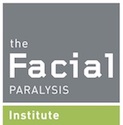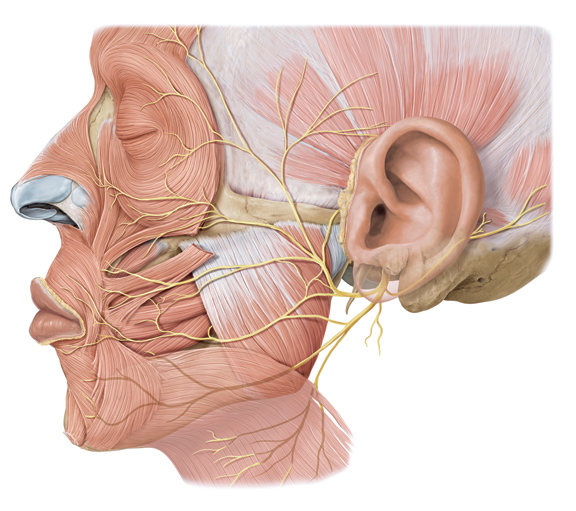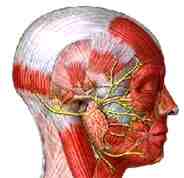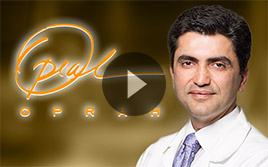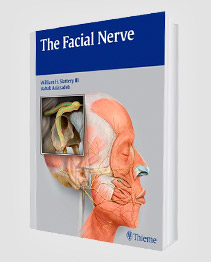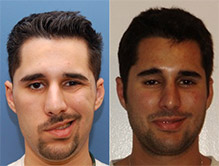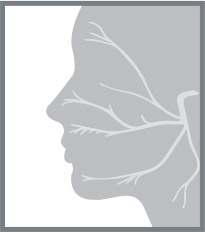Overcoming the effects of facial paralysis is a long and difficult process. Dr. Babak Azizzadeh and The Facial Paralysis Institute staff understand the importance of each step of the facial reanimation journey. Our goal is to provide a facial paralysis physical therapy program that facilitates facial symmetry and improves facial paralysis. With the proper exercises and facial therapy, facial paralysis patients can recover some of their lost facial movement and regain the ability to smile, frown, and make other facial expressions.
What Are Facial Nerve Recovery Exercises?
Although patients may undergo a procedure to correct facial paralysis and notice symptomatic improvement, they may require facial nerve recovery exercises to achieve the full results of facial paralysis physical. These exercises may be introduced during the recovery process, and they enable a patient to identify unwanted and involuntary facial muscle movements.
Dr. Azizzadeh helps patients address facial paralysis, Bell’s palsy and other facial nerve conditions. Dr. Azizzadeh is a world-renowned facial plastic and reconstructive surgeon. He possesses dual certification in facial plastic and reconstructive surgery and head and neck surgery (otolaryngology). Dr. Azizzadeh’s unique expertise has helped him become one of the most sought-after facial plastic and reconstructive surgeons in the world.
The effectiveness of facial symmetry exercises is often dictated by a facial paralysis patient. If a patient dedicates the time, energy, and resources to learn how to properly perform facial nerve recovery exercises, the patient is well-equipped to treat unwanted and involuntary facial muscle movements associated with conditions like Synkinesis. On the other hand, if a patient ignores the instructions provided by a physical therapist, the patient is unlikely to achieve the full results of a facial paralysis physical therapy.
At the Facial Paralysis Institute, we stress the importance of being evaluated by an expert neuromuscular therapist to learn the proper facial nerve recovery exercises. Upon evaluation with our physical therapists, you will learn the facial symmetry exercises necessary to correct facial paralysis symptoms.
Our customized facial paralysis treatment sessions are planned around each patient’s prognosis and the severity of their condition, including those suffering from Congenital facial paralysis. A facial therapy program is tailored to the patient, and our team offer support at every stage of the program.
Additionally, Dr. Azizzadeh and his staff utilize a number of techniques to help improve facial symmetry in facial paralysis patients. Below are two of the most common facial paralysis physical therapy approaches used by our physical therapists.
Physical Therapy Techniques for Facial Paralysis
Neuromuscular Retraining (NMR)
NMR involves the use of subtle but critically important exercises to teach and retrain the brain to coordinate the facial muscles more effectively and efficiently.
Benefits of NMR
NMR re-teaches facial paralysis patients which muscles are required to move different parts of the face. This facial paralysis treatment enables a patient’s brain to reconnect facial muscles and corresponding facial movements. As a result, this facial paralysis physical therapy technique helps patients isolate facial muscles in a way that suppresses unwanted facial movements, while being able to create their desired facial expressions
Am I a Viable Candidate for NMR?
Patients dealing with Bell’s palsy or other viral infections of the facial nerve often recover on their own completely and spontaneously within about three months of an initial diagnosis. For those who do not fully recover, it is possible that the facial nerve will heal improperly, which causes spontaneous, unwanted facial movements (or synkinesis). For example, when a Bell’s palsy patient tries to smile, his or her eye may twitch at the same time. In this scenario, the patient does not require additional strength in the facial muscles. Instead, he or she needs to improve facial muscle coordination to prevent facial muscles from flexing out of sequence – something that causes distorted facial movements.
For those who experience Bell’s palsy or other facial paralysis symptoms for eight months or longer, a consultation with Dr. Azizzadeh is ideal. At this time, Dr. Azizzadeh will conduct a full patient assessment, learn about a patient’s facial paralysis symptoms and determine the patient’s eligibility for NMR.
Manual Massage
Manual massage involves a series of different massage techniques. The goal of manual massage is to decrease facial muscle tightness and improve flexibility and range of motion. Initially, manual massage techniques may be performed by our physical therapists. But, our physical therapists ultimately teach patients facial therapy techniques so they can perform facial recovery exercises regularly at home.
Occupational Therapist Jackie Diels Explains Facial Muscular Retraining
Facial Neuromuscular Retraining After Facial Nerve Transfer
Facial Neuromuscular Retraining After Tumor Removal Surgery
Facial Neuromuscular Retraining After Bell’s Palsy
Facial Paralysis Surgery & Non-Surgical Neuromuscular Retraining
Facial Paralysis Physical Therapy & Neuromuscular Retraining
When Can I Start Neuromuscular Retraining?
Facial Muscular Retraining
Facial muscular retraining often plays a key role in the overall effectiveness of a facial paralysis treatment. It allows a patient to retrain the facial muscles so he or she can make coordinated facial expressions. As such, facial muscular retraining helps a patient optimize his or her facial paralysis treatment results.
Facial Neuromuscular Retraining After Facial Nerve Transfer
Facial neuromuscular retraining is generally recommended after facial nerve transfer surgery, and it is customized to a facial nerve transfer patient. For example, in some instances, the facial nerve overcorrects, resulting in hyper-contractions in the facial muscles. To address these issues, stretching, massaging and soft tissue mobilization may be required. These techniques can help reduce facial tissue tightness and make the facial tissue more supple. They also ensure that patients will know how to use only the required muscles when they make various facial expressions.
Facial Neuromuscular Retraining After Tumor Removal Surgery
The facial nerve is sometimes damaged during tumor surgery; in this instance, a patient requires additional time to recover after surgery. The recovery period after tumor surgery is typically longer in comparison to the recovery time associated with other facial paralysis procedures. The facial nerve heals at a rate of about 1 inch per month, and a patient may start to see the initial signs of recovery 10 to 12 months following treatment. At this time, a patient’s mouth starts to move upward, and this individual can begin a facial retraining program.
Facial Neuromuscular Retraining After Bell’s Palsy
Most Bell’s palsy patients recover completely and spontaneously within approximately three months of treatment. In all other cases, however, Bell’s palsy patients must strengthen their facial muscles and improve muscle coordination. With facial neuromuscular retraining, Bell’s palsy patients can learn to use the proper muscles associated with various facial expressions. For example, facial neuromuscular retraining teaches Bell’s palsy patients how to use the cheeks to pull the corner of the mouth to produce a natural-looking smile.
Facial Paralysis Surgery & Non-Surgical Neuromuscular Retraining
Facial paralysis surgery and facial neuromuscular retraining complement one another, and ultimately, ensure patients can achieve their desired treatment results. At The Facial Paralysis Institute, Dr. Azizzadeh performs facial paralysis surgery, setting the foundation for good facial muscle activity. Meanwhile, occupational therapist Jackie Diels performs non-surgical neuromuscular retraining to maximize facial paralysis surgery results.
Facial Paralysis Physical Therapy & Neuromuscular Retraining
Facial paralysis occurs due to tumors, viral infections, trauma and congenital defects. It prevents movement on one side of the face. For facial paralysis patients, the facial nerve gradually heals. But in some instances, the facial nerve fails to heal properly, resulting in uncontrollable and abnormal facial expressions.
Facial neuromuscular retraining teaches facial paralysis patients how to use the facial muscles to produce natural facial expressions. During facial neuromuscular retraining, facial paralysis patients initially learn which muscles are associated with different facial expressions. Facial paralysis patients then learn different exercises to strengthen the facial muscles and enhance muscle coordination.
When Can I Start Neuromuscular Retraining?
The right time to begin facial neuromuscular retraining varies based on the patient and the root causes of his or her facial paralysis symptoms. For instance, 85% of patients dealing with facial paralysis associated with Bell’s palsy, shingles or other viral causes recover naturally within about three months. Comparatively, facial paralysis patients dealing with delayed recovery should seek out facial neuromuscular retraining. These patients may experience facial synkinesis that causes eye twitching and other uncontrollable facial expressions.
Each facial paralysis patient is evaluated on a case-by-case basis. Next, a personalized facial neuromuscular retraining program is crafted for a facial paralysis patient. With this program in place, a patient can start facial neuromuscular retraining at the appropriate time based on his or her facial paralysis symptoms.
Is Facial Physical Therapy Safe?
Facial physical therapy benefits many facial paralysis patients. To determine if facial paralysis physical therapy is the best treatment option, Dr. Azizzadeh requests a consultation. This allows Dr. Azizzadeh to evaluate the patient and learn about their facial paralysis symptoms.
If Dr. Azizzadeh deems facial physical therapy a safe and effective treatment option, he offers a treatment plan. Or, if a patient may benefit from other facial paralysis treatment options, Dr. Azizzadeh provides insights into these options.
Can Facial Therapy Be Performed in Combination with Other Facial Paralysis Treatments?
Facial therapy may be one component in a facial paralysis treatment program. For instance, Botox, selective neurolysis, or other treatments may be used to address facial paralysis symptoms. After these treatments are administered, facial physical therapy exercises may be recommended.
Dr. Azizzadeh and the Facial Paralysis Institute team consider all treatment options to help a patient achieve long-lasting relief from their facial paralysis symptoms.
Are Facial Symmetry Exercises Necessary?
There may be times when facial paralysis physical therapy patients will benefit from facial symmetry exercises. In other instances, facial paralysis patients may benefit from other treatment options. To determine the best course of action, a facial paralysis patient must be evaluated. By meeting with Dr. Azizzadeh and the Facial Paralysis Institute team, facial paralysis patients can be comprehensively examined and find out if facial paralysis treatment and facial symmetry exercises may be beneficial.
Our Approach to Physical Therapy for Facial Paralysis
Facial paralysis, Bell’s palsy and other facial nerve conditions are complex. As such, a personalized facial paralysis physical therapy treatment program may be used to address facial paralysis symptoms. Once the program has been created, a patient can use physical therapy to achieve his or her desired results.
Dr. Azizzadeh and the Facial Paralysis Institute team take a holistic approach to physical therapy for facial paralysis. We understand there is no one-size-fits-all physical therapy treatment to address all types of facial paralysis. Therefore, we work with each patient to create a custom physical therapy program. We also monitor a patient’s progress and ensure a facial paralysis physical therapy treatment helps a patient alleviate facial paralysis symptoms.
Schedule a Facial Physical Therapy Consultation with the Facial Paralysis Institute
For more information about our customized approach to facial paralysis physical therapy and learn which facial exercises will be the best for your condition, please contact us today at (310) 657-2203 to schedule a consultation with facial paralysis expert Dr. Azizzadeh.
Next, check out our blog
Request your consultation with Dr. Azizzadeh today
Call us at (310) 657-2203 to schedule an appointment.
Schedule a Consultation